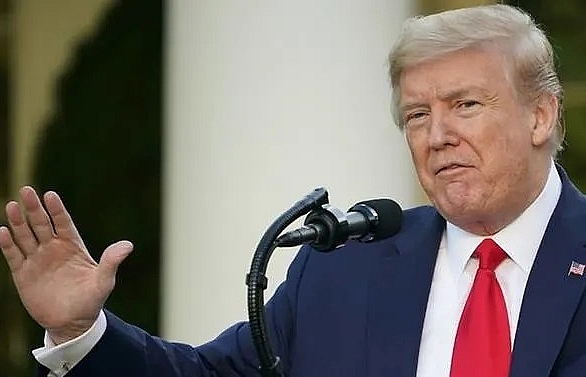Investors watching on weakened yuan
 |
| The Chinese yuan fell slightly against the US dollar |
The FX markets around the world were again shaken by US President Donald Trump, as he last week proposed an additional 10-per cent tariff on $200 billion worth of goods from China. Earlier the US began to inflict 25-per-cent tariffs on $34 billion worth of Chinese-made products. The yuan consequently saw itself falling some 3 per cent in value against the USD in the year to date. In response, last Thursday, the People’s Bank of China (PBOC) adjusted its daily fixing rate to CNY6.6726 for $1, posting a devaluation of 0.7 per cent as compared to the day before.
According to economist Nguyen Tri Hieu, although the PBOC said it would not use the CNY as a tool in the trade conflict, the monetary authority could have already had an inclination in mind to devalue its currency, which it then proceeded to carry out last week. The yuan’s steady decline, witnessed since mid-June, could well be a sign of China consenting to weakening its currency.
Hieu noted that the CNY/USD fall would not directly affect the CNY/VND rate, but would affect the import-export relations between the two nations.
“Transactions denominated in yuan aren’t significant in Vietnam,” Hieu noted. “Yet the yuan devaluation will take its toll on Vietnam’s balance of trade in the future.”
Data by the General Statistics Office shows that late June, Vietnam recorded a trade deficit of $14.5 billion with China. Given the CNY/USD reduction, Chinese goods would become relatively cheaper, which can benefit Vietnam’s imports from China. The trade deficit is therefore expected to widen, said Hieu.
Meanwhile, there are concerns that this depreciation of the yuan could replicate that of 2015, when the CNY’s 5 per-cent depreciation caused the VN-Index to slip by some 15 per cent and caused the VND to depreciate, despite Vietnam’s solid economic fundamentals of 6.7 per cent in GDP growth, the inflation of under 1 per cent and a modest trade surplus.
Traders, as a result, are watching the current movements in the USD/CNY closely, according to Michael Kokalari, chief economist at VinaCapital. Kokalari notes, “Part of the reason the 5-per-cent depreciation of the CNY has such a big impact on sentiments in Vietnam and other emerging market (EM) stock markets is because prior to that depreciation, China’s currency had been on a ‘slow but steady’ path of appreciation.
“The sudden end of this strengthening in 2015 derailed the market, but the subsequent 7-per-cent depreciation in 2016 did not have much of an impact on Vietnam’s stock market,” Kokalari reported on July 6.
In another market commentary dated July 6, VinaCapital said that the current sell-off in EM stock markets was initially triggered by a surge in the US dollar index in late April. This week, concerns that China’s currency and stock markets may repeat the turmoil endured in 2015 prompted more EM weakness - including a 4.4-per-cent drop in Vietnam’s VN-Index on Tuesday - despite guidance from China’s government that it does not want the yuan to depreciate by more than 4 per cent in the year to date.
“Vietnam’s stock market is swept up in the EM bear market,” the market report stated. “The sell-off of the VN-Index is being driven by exogenous factors, despite the country’s strong economic conditions and despite the relative stability of the Vietnamese dong (-1.8 per cent in the year to date), partly due to the State Bank of Vietnam’s commitment to stem VND depreciation at 2 per cent and despite the fact that Vietnam is not highly vulnerable to the risk factors causing alarm in other EMs.”
“Although it is difficult to foresee what is next for EMs and/or the dollar, it is clear that Vietnam is better positioned than most of its EM peers to weather the current storm,” the VinaCapital market report continued. “There are a few specific issues that are moderately worrying, but the overall relative outlook for Vietnamese stocks is much better than for other EMs.”
What the stars mean:
★ Poor ★ ★ Promising ★★★ Good ★★★★ Very good ★★★★★ Exceptional
Related Contents
Latest News
More News
- HSBC signs deal for first green trade facility in Vietnamese seafood industry (November 14, 2024 | 12:20)
- Banking on banks to finance the green transition (November 14, 2024 | 11:15)
- BAC A BANK builds on its prestige (November 14, 2024 | 09:41)
- A tale of two trends: Digital transformation and net-zero transition (November 14, 2024 | 09:30)
- Tra Khuc 2 Hydropower secures syndicated term loan worth $29.2 million (November 14, 2024 | 06:40)
- Monetary and credit policies supporting exporters (November 12, 2024 | 16:15)
- Funding change paves way for FTSE upgrade (November 11, 2024 | 13:00)
- Digital solutions are crucial for Vietnam’s tax future (November 11, 2024 | 10:09)
- Exchange and interest rates forecast to remain stable after US election (November 07, 2024 | 14:04)
- Industrial real estate stocks benefit from US election results (November 07, 2024 | 13:56)




 Tag:
Tag:

















 Mobile Version
Mobile Version